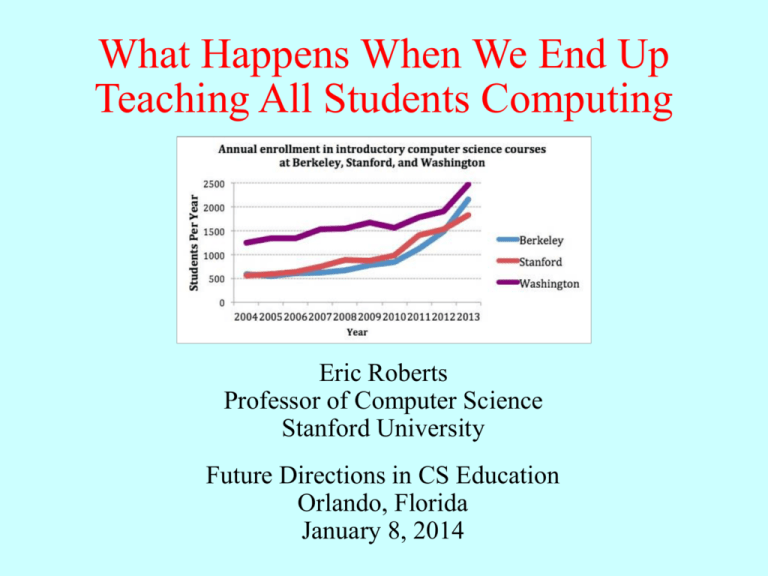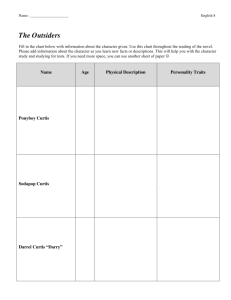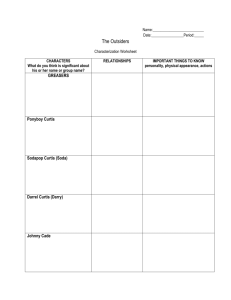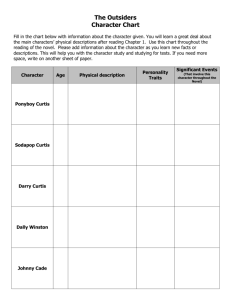sigcse 2007 - Stanford Computer Science
advertisement

What Happens When We End Up Teaching All Students Computing Eric Roberts Professor of Computer Science Stanford University Future Directions in CS Education Orlando, Florida January 8, 2014 Grady Booch at SIGCSE 2007 Passion, Beauty, Joy, and Awe That there is currently a crisis in computing education is not in doubt. — McGettrick et al., SIGCSE 2007 • As everyone has now been aware for some time, computing enrollments in the United States and most of Europe have plummeted since 2001. • This drop is of significant economic concern because those same countries are training far fewer people than they need to fill the available positions. In the United States, there are now many more jobs in the IT sector than there were at the height of the dot-com boom, with all projections pointing toward continued growth. —From my SIGCSE PBJA panel presentation in 2008 What a Difference a Year Makes That there is currently a crisis in computing education is not in doubt. — McGettrick et al., SIGCSE 2007 • As everyone has now been aware for some time, computing enrollments in the United States and most of Europe have plummeted since 2001. Are enrollments still falling? • This drop is of significant economic concern because those same countries are training far fewer people than they need to fill the available positions. In the United States, there are now many more jobs in the IT sector than there were at the height of the dot-com boom, with all projections pointing toward continued growth. Is this still true after the meltdown? • In Silicon Valley and at Stanford, the answers are clear: – Demand for talented software developers is as high as ever. – CS enrollments are skyrocketing, nearly erasing any previous loss. —From my SIGCSE PBJA panel presentation in 2009 The Demand for Computer Science Phil Levis, http://csl.stanford.edu/~pal/ed/ Doctorate Master’s Bachelor’s Job openings 161,857 129,045 94,889 49,200 57,127 55,208 31,357 10,075 Physical Sciences Biological Sciences Engineering Computer Science The educational data comes from the National Center for Education Statistics IPEDS (Integrated Postsecondary Education Data System) Data Center. The data used is for degrees granted in the 20082009 academic year. The employment data comes from the Department of Labor’s Occupational Outlook Handbook for 2010-11. This handbook includes employment for 2008 as well as a 10-year projection to 2018. I manually selected which occupations mapped to which degrees. I calculated job openings per year as 10% of the expected job growth over 2008-2018 plus 2.5% of the number of jobs in 2008. This second term describes the number of jobs opening as people retire. It assumes that people work for 40 years and leave a job at a uniform rate; the latter is of course not true in difficult economic times. Top Ten Majors at Stanford (as of July 2013) 1. 2. 3. 4. 5. 6. 7. 8. 9. 10. Computer Science Human Biology Engineering IDMs (mostly Product Design) Science, Technology, and Society Biology Economics Management Science and Engineering Mechanical Engineering International Relations Psychology Top Majors at Stanford (as of July 2012) Top Majors at Stanford (as of July 2013) The Student Growth Is Now Common • The problem of the 2000s was insufficient student demand. • The problem of the 2010s will be insufficient faculty capacity. • What we face is a “success disaster” in the making. Success Disasters Success Disasters "success disaster" Success Disasters "success disaster" Success Disasters "success disaster" We’ve Been Here Before • The situation that Computer Science is likely to face over the next five years is not unprecedented. Much the same situation occurred in the 1980s. • In the early 1980s, the availability of personal computers led to an explosion of student interest in computer science. At some universities, student demand doubled in a single year. • Unfortunately, universities did not have the capacity to satisfy the growing demand. – – – – Workloads for faculty increased substantially. Some faculty members began to leave for greener pastures. Replacement faculty were nearly impossible to find. Graduate students turned away from academic careers. The Kent Curtis Report The Kent Curtis Report The Kent Curtis Report The Kent Curtis Report Proposed Research Questions for NSF 1. What challenges make it difficult for institutions to build the necessary capacity? We Need a New “Kent Curtis” Report • In a time of significant downward pressure on educational funding, we will need as much solid data as possible to convince university administrators and legislators to increase funding for computer science. • Satisfying the demand from technology-related industry will require enormous changes in hiring priorities for universities that will not always be politically smooth. • Both industrial demand for software developers and student demand for computer science degrees are historically cyclic, which makes it harder for policymakers to fund CS education at what appear to be periods of peak demand. Unfortunately, this approach is a self-fulfilling prophecy. Proposed Research Questions for NSF 1. What challenges make it difficult for institutions to build the necessary capacity? 2. How can we maximize the production of students with the exceptional levels of talent that the industry demands? The Long View of History Variations in Programmer Productivity • In 1968, a study by Sackman, Erikson, and Grant1 revealed that programmers with the same level of experience exhibit variations of more than 20 to 1 in the time required to solve particular programming problems. • More recent studies2, 3, 4 confirm this high variability. • Most industry insiders believe that the productivity variance is even higher today. In 2005, Google’s VP for Engineering, Alan Eustace, told The Wall Street Journal that one top-notch engineer is worth 300 times or more than the average.5 1 2 3 4 5 H. Sackman, W. J. Erikson, and E. E. Grant. Exploratory experimental studies comparing on-line and off-line programming performance. Communications of the ACM, January 1968. W. Curtis. Substantiating programmer variability. Proceedings of the IEEE, July 1981. T. DeMarco and T. Lister. Programmer performance and the effects of the workplace. Proceedings of the 8th International Conference on Software Engineering. IEEE Computing Society Press, August 1985. G. E. Bryan. Not all programmers are created equal. In Richard Thayer, Software Engineering Project Management (second edition), IEEE Computer Society, 1997. T. Pui-Wing and K. Delaney. Google’s growth helps ignite Silicon Valley hiring frenzy. Wall Street Journal, November 23, 2005. Proposed Research Questions for NSF 1. What challenges make it difficult for institutions to build the necessary capacity? 2. How can we maximize the production of students with the exceptional levels of talent that the industry demands? 3. What strategies — including those outside traditional academic programs and curricula — will help to expand the pipeline of students in this critical area? The Ultimate Answer? Education and the French mindset Bangalore-sur-Seine? May 11, 2013 WHEN French entrepreneurs decided in March to launch a swanky new school for software developers, they thought they were on to something. But even they were startled by its popularity. For 1,000 student places starting this autumn on a three-year course, they have fully 50,000 applications. France has a skills mismatch. Joblessness has reached 10.6%, a 14-year high. For the under25s, it is 26%. Yet, according to a poll by the French Association of Software Publishers and Internet Solutions, 72% of software firms are having trouble recruiting—and 91% of those are seeking software engineers and developers. Dick Gabriel’s Proposal for a Software MFA Softwareapt education todaycan is be embodied Computer Another comparison found ininthe creative Science writing and ItSoftware programs, supplemented by arts. is entirelyEngineering possible to become an extraordinary writer informal mentoring on the job. and I find this and approach by one’s self, by simply writing reading, many unsatisfactory. development is a way performance excellent writers Software progress this way. A faster to gain exhibiting skills developed an individual—often in competence is through a Masterbyof Fine Arts program, which groups of teams in order to achieve is designed to rapidly increase one’s the skillsscale and ofto software get one required. toInbring this way, software is like putting prepared to bear criticaldevelopment thinking to the process of on a play, which requires Some the skills and that performances continuing improvement. believe all aspectsofofa number of people in tandem on stage and behind software design andworking development are really engineering or the scenes.disciplines Such skillswhere can bethe developed in isolation through scientific models of engineering and practice apply, with other even by putting in science and Iamateurs will notorquarrel with themon norplays try to public without any training convince them otherwise. . . . at all. But how much faster could be is developed educational that <tab> Thistalent proposal predicatedinona the belief that program being a good recognizeddesigner that writing software has enoughtalent, of an and arts-like software and developer requires that performance programliken was the tailored to it?of talent can be component developed. that We the explicitly practice software to the practice of fine art. http://www.dreamsongs.com/MFASoftware.html Dick Gabriel software wizard prizewinning poet Alternative Models of Software Education Although Dick Gabriel’s model of an MFA in software is worth investigating, it may be more appropriate to create “conservatories” for the teaching of software arts, similar to music conservatories. One possibility might be some sort of New England Conservatory of Coding. (Or Or perhaps perhaps a Hogwarts School for Software Wizardry.) Wizardry. SEMESTER AT C++ SEA Another model might be to create intensive programs that encourage students to focus on the art of software development, in much the same way that programs like the University of Virginia’s Semester at Sea program offers a concentrated immersion in oceanography, geography, and cultural anthropology. References 1. Kent Curtis. Computer manpower—Is there a crisis? National Science Foundation, 1982. http://cs.stanford.edu/Curtis-ComputerManpower/ 2. Peter Denning. President’s letter: Eating our seed corn. Communications of the ACM, June 1981. http://dx.doi.org/10.1145/358669.358672 3. Richard P. Gabriel. Master of Fine Arts in Software. 2002. http://www.dreamsongs.com/MFASoftware.html 4. Eric Roberts. Meeting the challenges of rising enrollments. ACM Inroads, September 2011. http://dx.doi.org/10.1145/2003616.2003617 5. Ed Lazowska and Dave Patterson. Letters: Students of all majors should study computer science. Chronicle of Higher Education, November 26, 2013. http://chronicle.com/blogs/letters/students-ofall-majors-should-study-computer-science/ The End







